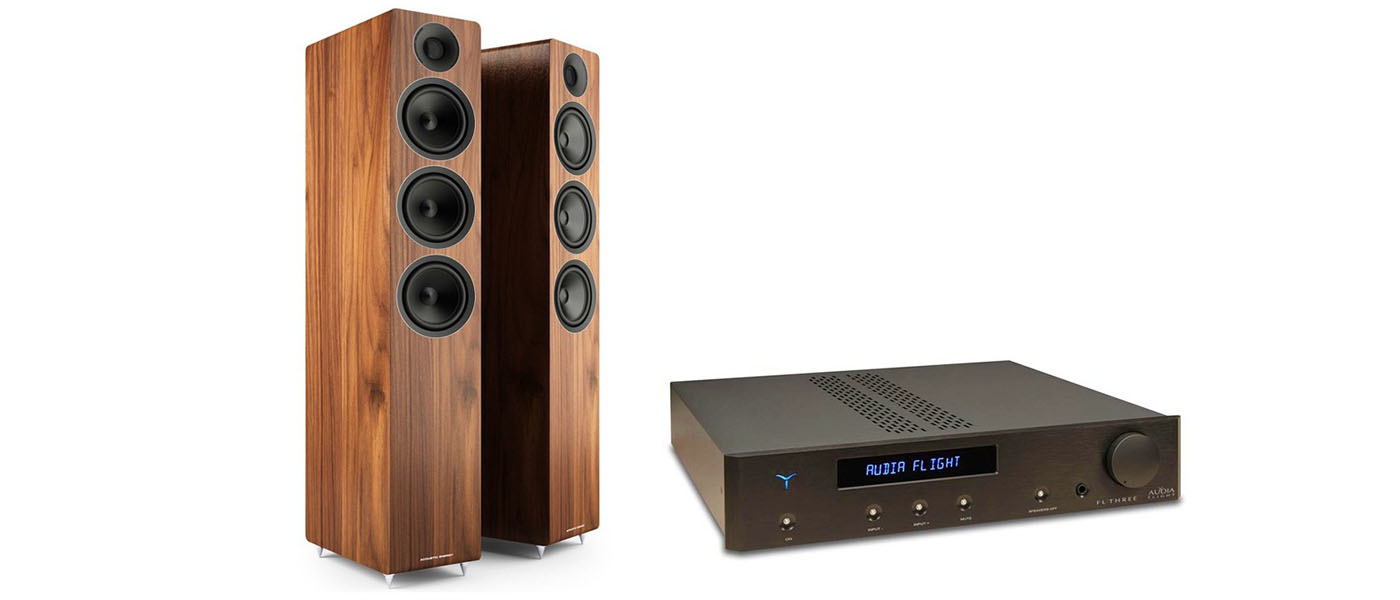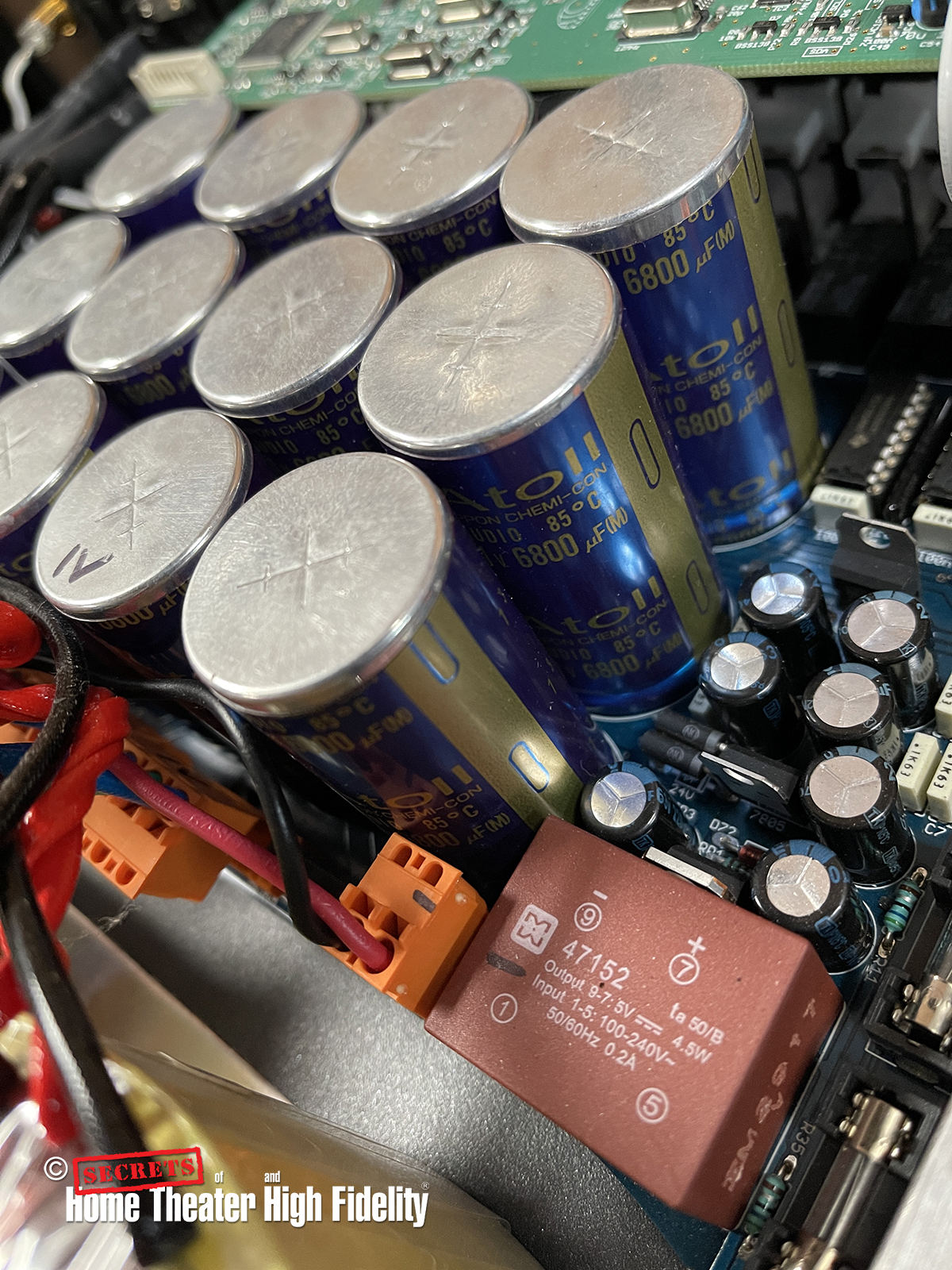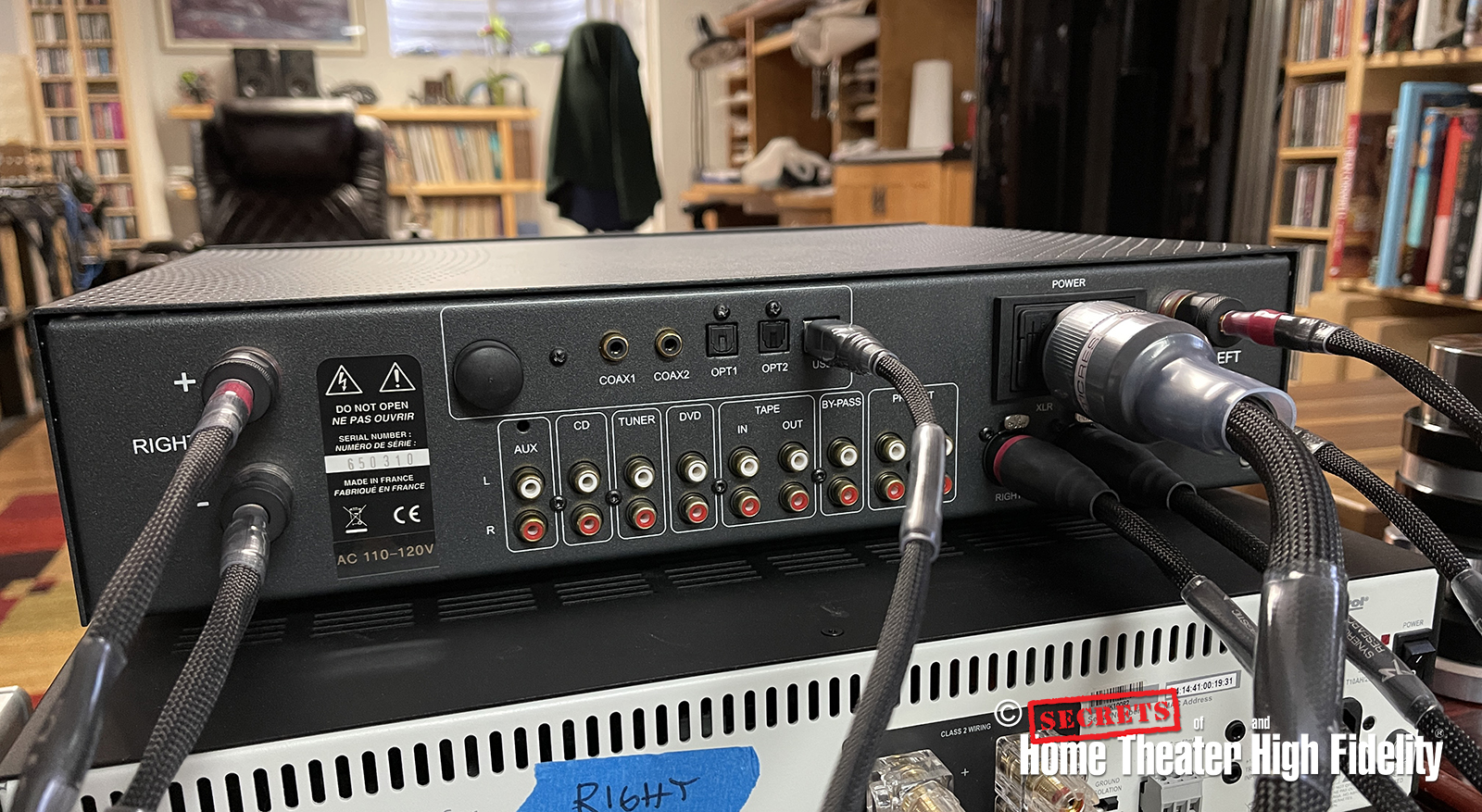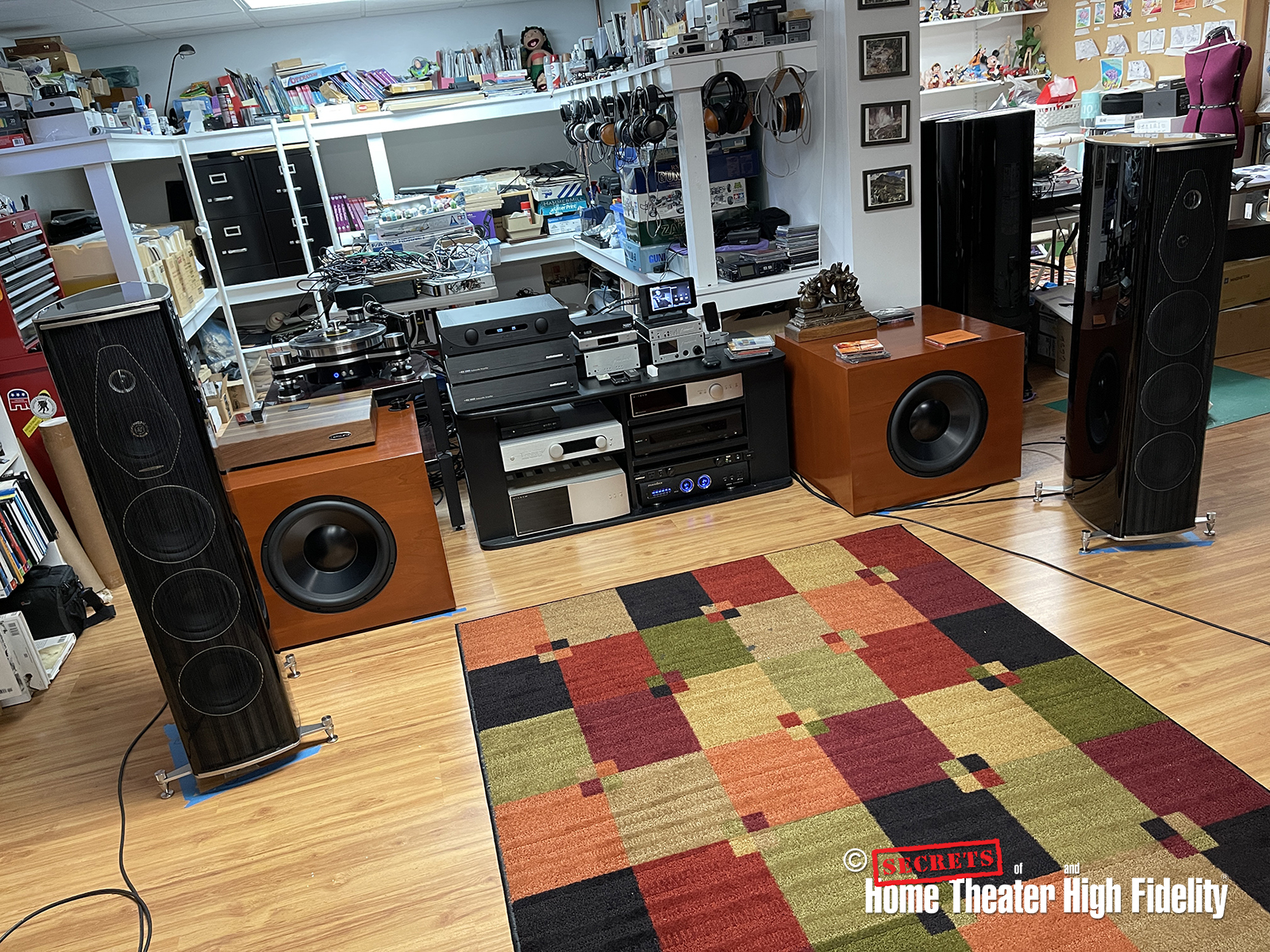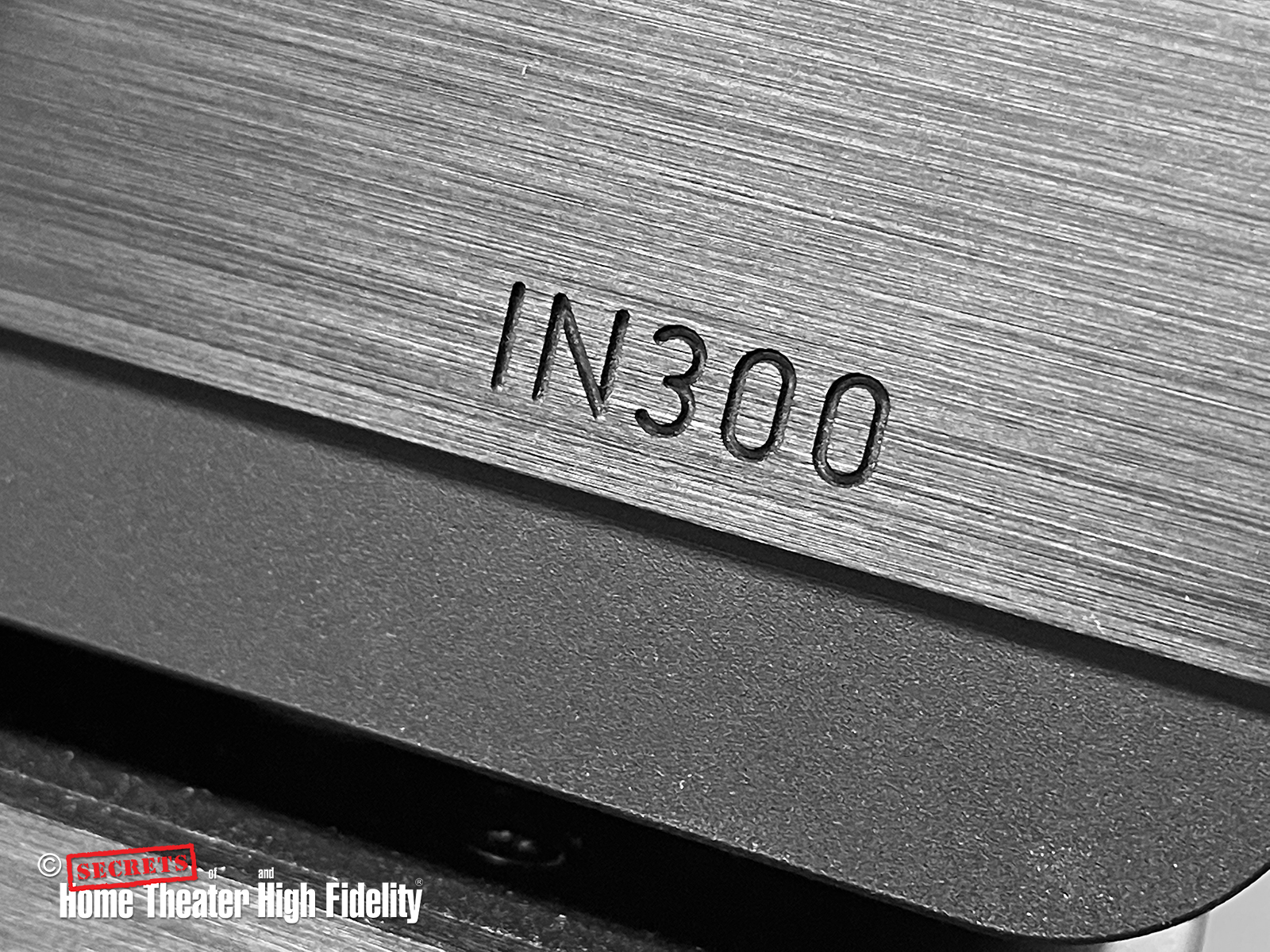Integrated amplifiers are increasingly expected to do more these days. Stream audio, network with other components, communicate via Bluetooth, etc. The Atoll IN300 keeps things decidedly simple with a streamlined, essential feature set but with a focus placed on getting the best quality performance from the whole. It looks pretty darn sharp too with an excellent level of fit and finish.
Atoll Electronique IN300 Integrated Amplifier Highlights
- Dual-mono design with two large toroidal transformers.
- Digital inputs including USB.
- Bluetooth receiver built in.
- 2 pairs of “Pre-Out” jacks and an HT Bypass.
- Very high-quality feel and finish.
- Warm yet detailed sound quality.
- Kept tight control of every speaker I connected to it.
Atoll Electronique is a French HiFi Company established in 1997 in the Normandy region of France. The company’s goal since the beginning has been about developing completely French-manufactured audio components with an eye toward rational, intelligent design and high overall value. To that end, Atoll offers a wide array of source, control, and power components spread across 6 different product lines to accommodate a variety of budget ranges. Design features like dual-mono construction, using the highest quality discreet components, MOS-FET transistors, and Class A/B amplification stages show a preference towards reliable, tried-and-tested technologies and methods. I was unfamiliar with the brand until Emilios Mandalios from US distributor Audio Excellent sent me the IN300 along with the equally French Atohm GT2-HD loudspeakers to review. “Check them both out and see what you think. I suspect you might be surprised!” were his thoughts on the subject. Always open to the unexpected, I decided to explore further.
The Atoll IN300 integrated amplifier resides in the company’s second-to-highest product range. Simple, elegant design without any superfluous features, the IN300 looks to be an option for listeners who value an integrated amplifier with superior quality and musicality over a more “kitchen sink” approach. Is it a “sleeper” then? A wolf in sheep’s clothing? Fine French pastry or bottled French dressing? Let’s put the IN300 through its paces and see what she ultimately brings to the table!
Design:
Dual mono Class AB integrated Stereo Amplifier.
Power Output:
2 x 150 Watts @ 8 Ohms, 2 x 260 Watts @ 4 Ohms.
Bandwidth (Manufacturer):
5 Hz to 100 kHz.
Input impedance:
220 kOhms.
Sensitivity:
540 mV.
Signal/Noise ratio (Analog):
100 dB.
Distortion at 1 kHz:
0.05% / (10 W).
DAC Chipset:
AKM-AK4490.
Signal/Noise ratio (Digital):
120 dB.
Supported digital formats:
Up to 24 bits, 192 kHz on coaxial and optical inputs. Up to 32 bits, 384 kHz on the USB-B (asynchronous) input. DSD: 2.8 MHz and 5.6 MHz on the USB-B (asynchronous) input.
Inputs:
2 x SPDIF Coaxial Digital, 2 x Toslink Digital, Single USB-B Asynchronous Digital (Requires custom XMOS driver), 1 x Wireless Bluetooth input, 5 RCA Line inputs (including 1 AUX for optional phono card), 1RCA BY-PASS input, 1 XLR input.
Outputs:
1 Pair of loudspeaker outputs, 2 Pre-out outputs, 1 Headphone output Ø 6.35 mm,1 Trigger output (12V).
Dimensions (W x D x H):
440 × 365 × 103 mm.
Weight:
16 Kg
Colors:
Black or Silver.
Accessories:
IR Remote Control, Power Cable.
MSRP:
$4500.00
Website:
SECRETS Tags:
atoll, in300, integrated amp, amplifier
Visually, the Atoll IN300 is a simple and tasteful-looking component with minimal adornments. The 8mm aluminum faceplate with its gently curved corners combined with the two matching, softly convex, aluminum Source Selection and Volume knobs convey both substance and elegance.
The Source Selection knob also doubles as an ON/OFF switch when pushed. The simple edge break that bisects the full width of the faceplate is a nice visual touch, along with the pattern of ventilation holes across the top and sides of the casework.
The substantive nature of the IN300 also comes across in its weight, at 17 Kg (almost 35 lbs.) It caught me completely by surprise as I initially lifted it out of its box. Any integrated or power amp of similar dimensions I’ve previously encountered has never weighed this much. It’s a dense little beast.
Unscrewing and sliding off the perforated casing revealed the main reason for the IN300’s unexpected mass. We are greeted with a proper dual-mono amplifier architecture with two substantial toroidal transformers and completely separated Left and Right channel circuit topologies. A bank of 12 large power capacitors, courtesy of Vishay, sit just behind the transformers. A total of 12 MOSFETS (6 running along either side) are each connected to large heatsinks ensuring the declared 150 watts per channel into 8-ohms remains relatively cool-running. All indications are that this is a properly designed and well-put-together amplifier section.
The back side of the IN300 is laid out in an equally straightforward manner. The digital inputs are configured in a row across the top. They consist of the Bluetooth antenna, two coaxial inputs, two optical inputs, and a single Asynchronous USB input. An AKM AK4490 DAC chipset handles all digital processing from each of these inputs, and a custom Windows USB driver is available for download from the Atoll website. Below the digital inputs is a full bank of RCA analog inputs. The first four pairs are standard RCA inputs although the first pair, marked AUX, can be configured from the factory as a phono input with the optional Atoll P50 MM add-in card or the P100 MM/MC add-in card. The review sample did not have any phono capabilities installed. After the first four inputs comes a tape monitor input-output set, a set of inputs marked Bypass (for home theater bypass), and then two pairs of Pre output jacks. Lastly, a pair of balanced XLR inputs are included. A set of custom tellurium-copper speaker binding posts are placed at either side of the back panel and an IEC power cord input with an integrated master switch and fuse complete the connection options.
Secrets Sponsor

The Atoll IN300 was set up in my regular 2-channel listening area, a large working art studio space. I was able to pair the Atoll IN300 with a variety of speakers during its stay, including the Revel F228Be, the Bowers and Wilkins 803 D4, the Paradigm Founder 120H, and the Sonus faber Olympica Nova V. Sources included my OPPO BDP-105D Universal player, my DIY Raspberry Pi-based ROON endpoint (connected via USB), the VPI Avenger Direct turntable with an Audio-Technica ART20 MC cartridge, and a Parasound ZPhono XRM phono preamplifier. The cables are Synergistic Research Foundation SX.
Secrets Sponsor
I’m not going to get into that age-old debate as to whether well-designed amplifiers sound significantly different from one another. Suffice it to say that I have found that amplifiers, regardless of type, can be tuned with a certain distortion profile, thus giving them a particular “voice.” Usually, I’ve noted the differences between similar types of amps. If differences exist, they are usually subtle (allowing for the occasional exception). In general, tube amps can vary more widely than solid-state.
While in my possession, I was able to compare the Atoll IN300 with my reference Benchmark Media Systems stack (HPA4 preamp, AHB2 power amp, and DAC3 B DAC), and the Technics SU-R1000 integrated amplifier.
Connecting my DIY Roon endpoint was an easy affair. A USB connection to the IN300 along with installation of the custom driver on my Microsoft Surface 3 PRO tablet that acts as my Roon Core, and full streaming services were up and running in no time.
Once I got the Atoll hooked up with my reference Revel F228Be speakers, I was immediately struck with the impression that this was one bold sounding amplifier. I know. It’s not a very technical explanation. But the Atoll IN300 sure gave the impression that it was exercising the kind of tight control over my speakers that I was not entirely expecting from a modestly-sized integrated amp.

Eiji Oue “Exotic Dances From The Opera”
When listening to “The Snow Maiden Opera” from “Reference Recordings Exotic Dances from the Opera,” the IN300 impressed with the level of bass impact it was able to coax from my Revels while fully keeping its composure at higher volumes. When compared to my Benchmark stack and even the Technics SU-R1000 that was here at the same time, the Atoll IN300 stood out with a slightly darker presentation than the others. It certainly handled the details and the dynamics well in both the aforementioned “Snow Maiden” track and on “Salome’s Dance,” but the level of ultimate transparency was not quite the same as the other two amps. It was a deeper and meatier sound overall. Still enjoyable, just different. And regardless of the bombast of the musical content I was playing, the IN300 remained no hotter than gently warm to the touch. I would advise however that if placed in a component case or entertainment center, a few inches of space be left around the IN300 for heat dissipation.
This sort of darker-sounding, tight-fisted domination at the speaker level continued when I paired the Atoll IN300 together with the Bowers & Wilkins 803 D4 loudspeakers. This pairing I felt worked particularly well as the 803 D4, which normally had a somewhat ruthlessly critical top end, had that tempered a little bit with the Atoll’s darker sound signature.

Steely Dan “Pretzel Logic”
Switching musical gears to Steely Dan’s “Pretzel Logic” SHM SACD turned out to be a good choice as the jazzy yet slightly ominous organ opening to the title track reeled me in. Donald Fagan’s vocals sounded perfectly centered, although a little fuller than I am used to hearing them. I didn’t find it distracting, however. The drum hits had a solid weight behind them but remained tight. Jeff Baxter’s guitar solo came across with just the right level of “twangy nastiness” that makes it so good. Credit the B&Ws for that razor’s edge treble that helps with that. But the Atoll’s seemingly unshakable power delivery compelled me to keep edging the volume up and it just kept sounding better. Ditto when we arrived at the track “With a Gun” with its rapid-fire pedal steel guitar flourishes and solo, also courtesy of Jeff Baxter. For my tastes, both the IN300 and the B&W 803 D4s individual sonic qualities seemed to have a knack for balancing each other out.
I also had a chance to pair the Atoll IN300 with the Sonus faber Olympica Nova V while they were in-house, and this also turned out to be another lovely-sounding pairing. The VPI Avenger Direct turntable had just arrived for review, and I decided to inaugurate its time with me with the IN300. The Parasound ZPhono XRM’s XLR outputs allowed me to use the Atoll’s balanced inputs for vinyl listening. So, after having installed the Audio-Technica ART20 MC cartridge and dialing in the VPI table, I began to play some records. What initially started as just a day of playing some favorite albums turned into a weeklong vinyl lovefest. This setup sounded good. I mean stupidly good! The Sonus faber speakers had naturally gelled with my room better than some other speakers I’ve had here. Bass reach was especially extended and consistent, vocals and midrange instruments were just lush and appealing, and the treble performance remained exciting without getting irritating in any way. The Atoll IN300 took these already enviable sonic qualities and just doubled down on them. Its tight-fisted control over the Sonus faber’s just made the bass hit harder, and its meaty and darker tonal qualities filled out vocals and instrumentation even more. And whatever alchemy the VPI/Audio-Technica/Parasound combination was weaving into the musical tapestry was on another level entirely.

Kenny Dorham “Quiet Kenny”
Playing the mono rerelease of Kenny Dorham’s “Quiet Kenny” delivered a liquid-smooth and enveloping sound over an exceptionally quiet background. Tracks like “Blue Friday” maintained a lovely balance between Dorham’s smooth and almost palpable trumpet playing, the brassy sheen of the ride cymbal, and the tight, solid plucks from the standup bass. When listening to “Alone Together” this component combination fused so well that the song literally just envelopes and melts the heart. It compels you to want to hold whomever you consider your beloved very tightly and not let go.
The folks at Atoll also knew what they were doing when thoughtfully including the unbalanced headphone jack. Trying a few different headphones with the IN300 revealed a very good-sounding head amp section with enough drive to push my 250-ohm Beyerdynamic DT880 PRO, HIFIMAN HE1000v2, and new Focal Utopia headphones (review coming soon) to clean, high volumes with room to spare. I had noted previously how I felt the headphone section of the Technics SU-R1000 sounded a little thin with certain headphone combinations. That was not the case at all with the IN300. The engineers at Atoll cooked up a head amp section that sounded uniformly good with whatever I tried.
The Atoll IN300 is akin to a sledgehammer in a fine-tailored suit. It extolls power and finesse in equal measure and it’s certainly worth your time for a listen.
- Clean, understated looks.
- Dual Mono design.
- Quality components and robust build.
- Powerful, slightly darker sound signature.
- HDMI ARC input
- Perhaps a newer DAC chipset. The AKM 4490 has been around for a while.
- XLR Pre-Outputs.
The Atoll IN300 integrated amplifier, like the Atohm GT2-HD loudspeakers that I reviewed previously, is a finely crafted French audio component that is likely not top of mind with most audio enthusiasts. Frankly, that’s a little bit of a shame because I’ve found it to be certainly worth considering. Its understated good looks hide what looks like a heavy and well-designed component. One that, while light on the bells and whistles, delivers an appealing sound and more than enough power to easily handle some good-sized tower speakers. With plenty of digital and analog inputs, the IN300 is a very flexible, classic integrated amplifier. And with a proper dual-mono balanced design, the IN300 is more than a few steps above mainstream integrated amps in the build and sophistication departments. If I could made one suggestion for improvement, I would like to see an HDMI ARC input. Still, with enough optical and coaxial digital connections, it’s not a complete loss to connect a TV to the Atoll.
One of the more fun parts of my job as a reviewer is finding surprises. Components that in one way or another represent an unexpected value or deliver unexpected satisfaction that I was previously unaware of. The Atoll IN300 integrated amplifier fits very neatly into that category. A serious Hi-Fi component from our friends in France that is built like a tank and musically delivers much more joy and satisfaction than you might expect.


